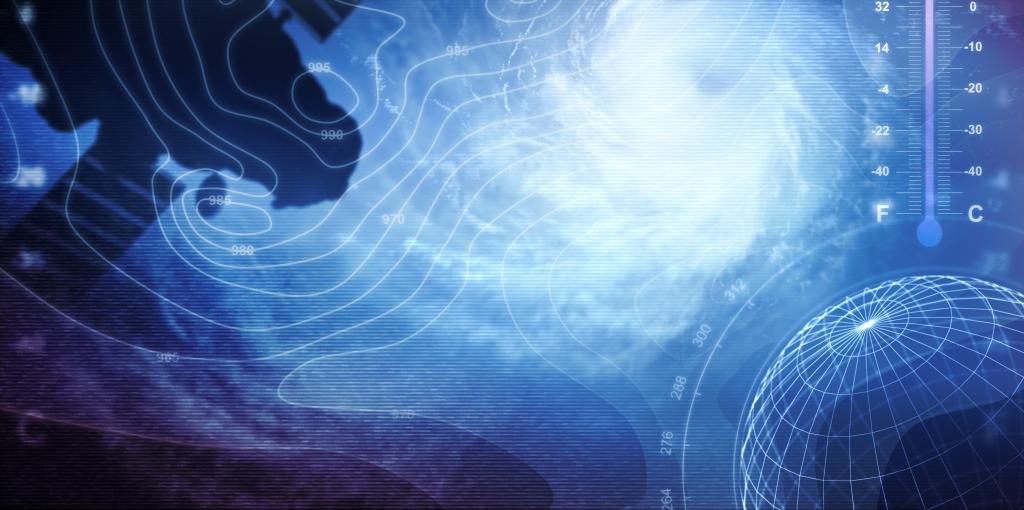2020-2021 Seminars
Admission CTAs
Main navigation
Section Navigation: AOES Seminars
Spring 2021 AOES Seminars
All seminars are virtual. To obtain the link to a seminar: For GEOL, see detailed information for individual seminars. For CLIM, contact bklinger@gmu.edu. For GEOL, contact Linda Hinnov through lhinnov@gmu.edu
28 Jan (GEOL) Chizmadia, Cosmochemistry
Lysa Chizmadia, Georgia SW State University
Cosmochemistry
Thu, 4:30-5:45pm
3 Feb (GEOL) Goldspiel, Planetary Science
Jules Goldspiel
Planetary Science
Thu, 4:30-5:45pm
4 Feb (GEOL) Mohamed, Marine Science
Saad Mohamed,UT-Rio Grande Valley
Marine Science
Thu, 4:30-5:45pm
10 Feb (CLIM) Hanrahan, The Climate Consensus
Janel Hanrahan, Northern Vermont U.
The climate consensus – creating a multi-institution outreach network
Wed., 1:30 pm
The consequences of unmitigated climate change are dire. Despite this, public belief in the severity of the crisis is mixed, and generally not well aligned with the current state of the science—a disconnect that is stalling efforts toward constructing a meaningful course of action. Through the creation of a climate outreach network, upcoming and established geoscientists will collaborate to promote effective dialog between scientists and the community. By sharing resources and best practices, learning from each other’s successes and failures, providing technical and moral support, and empowering the next generation of scientists, we have an immense opportunity to shape public opinion on this topic and to motivate real action.
11 Feb (GEOL) Carmichael, Geomicrobiology
Sarah Carmichael, Appalachian State University
Geomicrobiology
Thu, 4:30-5:45pm
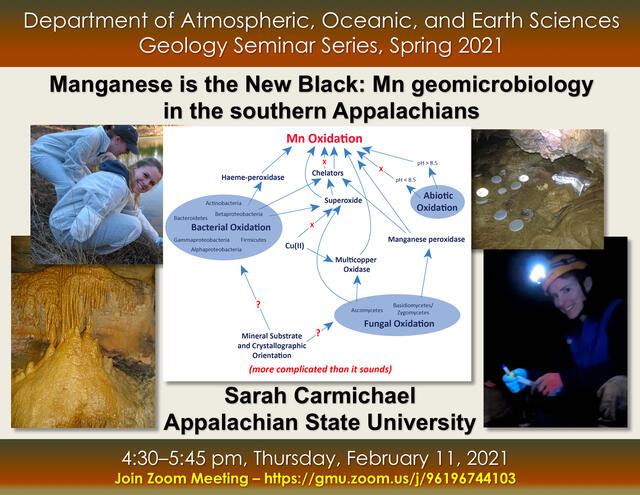
12 Feb (CLIM) Current Climate Conversations (CCC)
Current Climate Conversation
Fri., 1:30
Quasi-monthly AOES discussion of notable recent climate and weather events. Come with an interesting news item. Come to add your two cents. Or just come to listen.
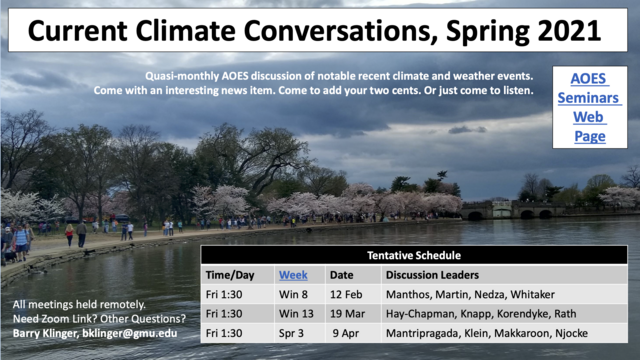
17 Feb (CLIM) Miralles-Wilhelm, Water Scarcity
Fernando Miralles-Wilhelm, AOES
Human demand vs climate change: which dominates water scarcity around the world?
Wed, 1:30
Socioeconomic change and an evolving climate system play a vital role in water use. This investigation uses a consistent economic modeling framework to address how changing conditions alter global water futures. First, efficiency changes are explored by extending the Shared Socioeconomic Pathways to the water sector. Water demand can be reduced if lower-income regions adopt appropriate technological advances. Second, the relative contributions of climate and human systems on water scarcity are analyzed at global and basin scales. Human systems dominate water scarcity in all scenarios, and human interventions decrease water scarcity in the sustainability-focused scenario. Third, international agricultural trade is analyzed. Water scarce areas of the Middle East and Africa will increasingly rely on China, the United States, and portions of South America to provide the necessary exports to meet demand.
18 Feb (GEOL) Guice, Ultramafic Rocks
George Guice, Smithsonian - Igneous petrology
Ultramafic Rocks
Thu, 4:30-5:45pm
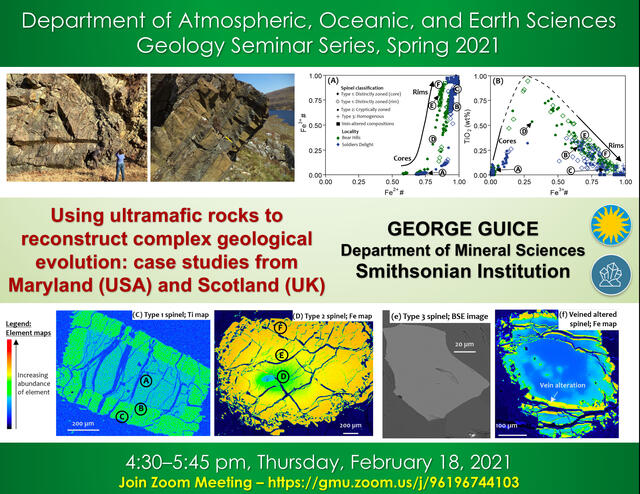
24 Feb (CLIM) DelSole, New Insights into Predictability
Tim DelSol, AOES
New insights into predictability
Wed, 1:30
25 Feb (GEOL) Over, Devonian Conodonts
Jeff Over, Geneseo
Devonian Conodonts
Thu, 4:30-5:45pm
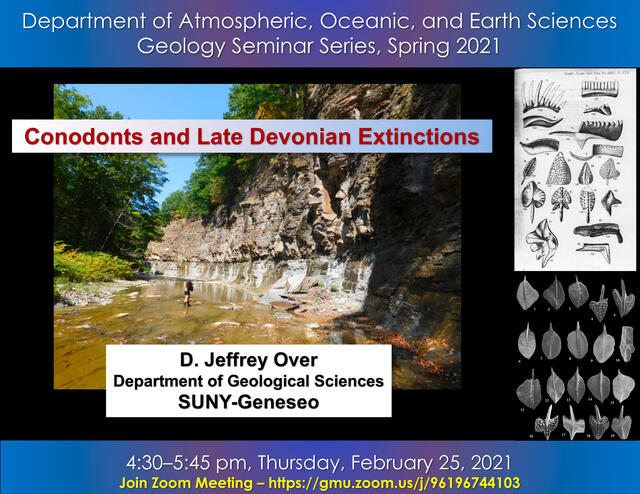
3 Mar (CLIM) Kalnay, Weather Forecasts Without Cheating?
Eugenia Kalnay & Tse-Chun Chen , U. Maryland
Can we improve substantially weather forecasts using future observations without cheating?
Wed., 1:30
Past studies showed that weather forecasts are improved when proactive quality control (PQC) rejects detrimental observations based on ensemble forecast sensitivity to observations (EFSO). However, the impact of cycling PQC in sequential data assimilation has, so far, only been examined in the simple Lorenz ’96 model. Using a low-resolution spectral GFS model, this study (Chen and Kalnay, Mon Weather Rev., 2020) aims to become a bridge between a simple model and complex operational systems. We demonstrate a major benefit of cycling PQC from the accumulation of improvements from previous PQC updates. As a result, it is unnecessary to use future information, and hence this allows the operational implementation of cycling PQC. The method improves forecasts throughout the 10 days of integration, provides more than a 12-h forecast lead-time gain, and reduces substantially both RMS errors and biases in the forecast.
4 Mar (GEOL) Chulliat, World Magnetic Model
Arnaud Chulliat, NOAA
World Magnetic Model
Thu, 4:30-5:45pm
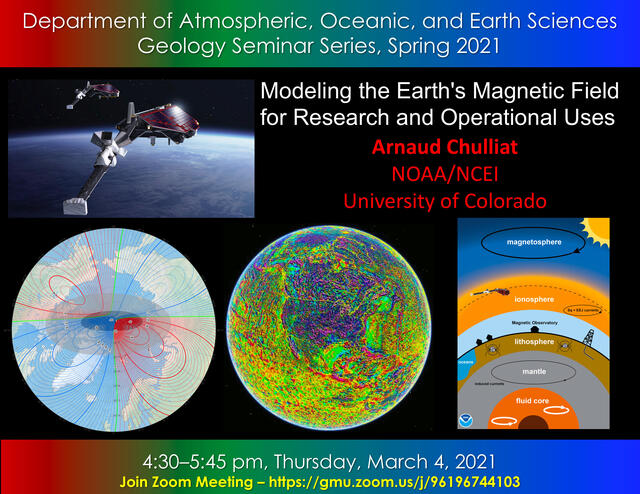
10 Mar (CLIM) Dee, El Nino Over the Past Millenium
Sylvia Dee, Rice U.
On the reliability of the El Nino-Southern Oscillation over the past Millenium
Wed., 1:30
Observations of 20th century climate are too short (back to 1900) to fully characterize decadal and centennial variability in the climate system. To augment the relatively brief instrumental record, high-resolution paleoclimate data record the pulse of the planet over timescales for which we have no direct records, provide a means for investigating extremes in past climates as an analog for future conditions, and help constrain statistics for climate variability. This talk describes novel strategies for improved predictions of climate system behavior, specifically surrounding the El Niño-Southern Oscillation (ENSO), by combining data from models, instrumental data, and high-resolution paleoclimate archives. These new methods are applied to key questions concerning anthropogenic impacts on ENSO and past and future extremes in hydroclimate variability. Future projections of water stress will depend crucially on such improved estimates of ENSO variability on longer (decadal to centennial) timescales.
11 Mar (GEOL): Servais, Forearc Exploration
John Servais, Utah State University
Forearc Exploration
Thu, 4:30-5:45pm
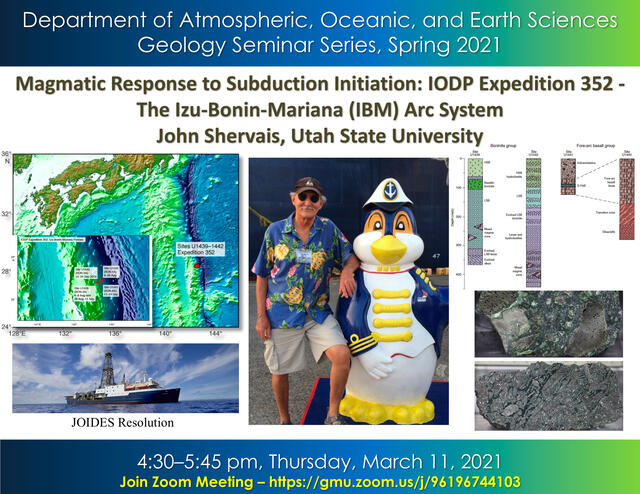
17 Mar (CLIM) Clement, Atlantic Mutlidecadal Variability
Amy Clement, U. Miami
The Causes and Consequences of Atlantic Multidecadal Climate Variability
Wed., 1:30
18 Mar (GEOL) Schaller, Isotope Geochemistry
Morgan Schaller, Rennsalaer
Isotope Geochemistry
Thu, 4:30-5:45pm
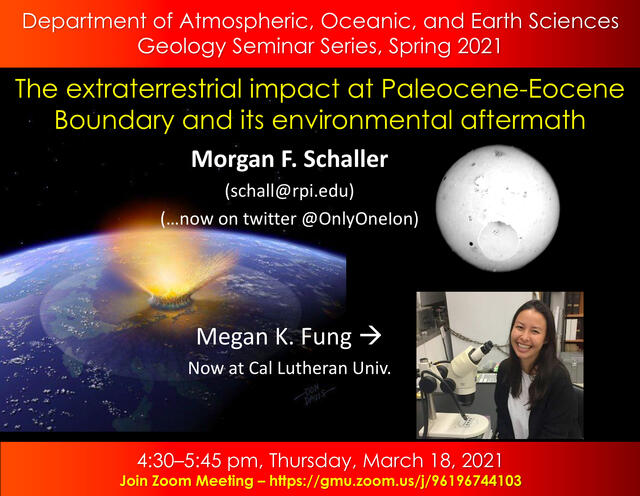
19 Mar (CLIM) Current Climate Conversations (CCC)
Current Climate Conversation
Fri., 1:30
Quasi-monthly AOES discussion of notable recent climate and weather events. Come with an interesting news item. Come to add your two cents. Or just come to listen.

24 Mar (CLIM) Findell, Land-Atmosphere Interactions
Kirsten Findell, NOAA Geophysical Fluid Dynamics Laboratory
Land-atmosphere interactions: from local to continental scales
Wed., 1:30
25 Mar (GEOL) Rivera, Geochronology
Tiffany Rivera, Westminster College
Geochronology
Thu, 4:30-5:45pm
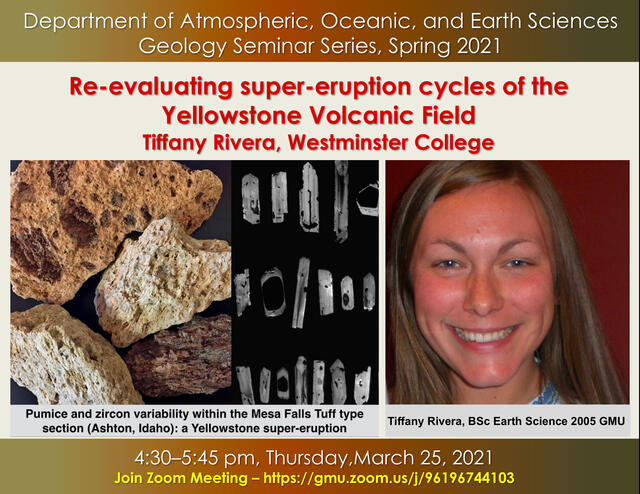
31 Mar (CLIM) Student Seminars #1
Climate Dynamics Doctoral Student Presentations
Hsin Hsu
Olivia Gozdz
Rachel Gaal
Wed., 12:30
1 Apr (GEOL) Potter, Project Hotspot
Katie Potter, Utah State University
Project Hotspot
Thu, 4:30-5:45pm
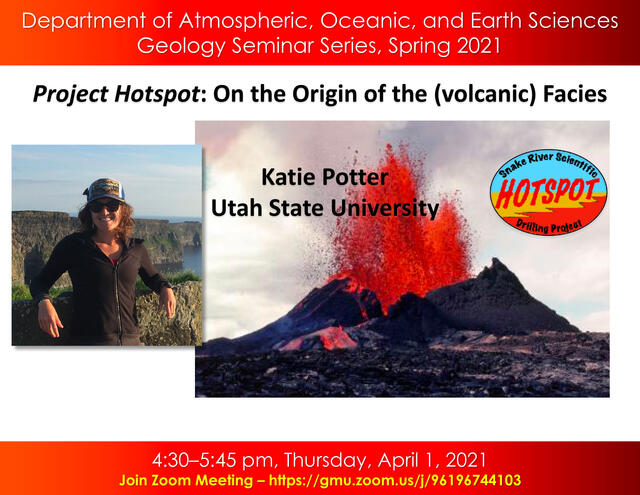
7 Apr (CLIM) Jon Martin, MS Thesis Defense
Jon Martin, Climate Science Thesis Defense
Predictability of the North Atlantic Sea Surface Temperatures in Observations and an Eddy-Resolving Coupled Climate Model
Wed, 7 Apr, 1:30
Advisor: Natalie Burls
This study uses linear inverse modeling (LIM) to examine the predictability of North Atlantic sea surface temperatures (SSTs) in both observations and simulations of an unforced coupled climate model. For observations of historical North Atlantic SSTs from 1919 to 2018, we assess how predictability is impacted by the way in which the climate change signal is removed from the basin across three different observed SST datasets. In the climate model simulations, which possess no externally forced signal, we examine the influence of increasing the ocean resolution to an eddy resolving scale (0.1 degrees Lon/Lat) on the predictability of North Atlantic SSTs.
Analysis of the observations finds that 1) SSTs in the Irminger Sea and Iceland Basin have the highest predictability within the North Atlantic and 2) basin averaged SSTs are predictable at a time scale of 3-5 years. The modes calculated based on the LIM supports these predictability results: all of the least damped modes, regardless of detrending method or dataset, indicate memory storage around the Irminger Sea and Iceland Basin with a decay timescale of 4.5 to 5 years.
Neither the 3-5 year range of basin-wide predictability nor the enhanced Irminger Sea and Iceland Basin predictability are present in the SSTs of the eddy-resolving climate model. Examining the LIM eigenmodes for this dataset shows that the low Irminger Sea and Iceland Basin predictability is primarily the result of variable subsurface heat storage and a shallow mixed layer in these regions. It is worth noting that the climate model’s external forcing (i.e. greenhouse gas and aerosol concentrations) is fixed and thus one possible caveat in comparing the results of the simulations to those of observations is that neither detrending method has completely removed the forced signal from observed SSTs. That said, results of our study, regardless of detrending method, show the Irminger Sea and Iceland Basin to be highly predictable regions within the observed North Atlantic and the fact that this is not the case in the simulation is likely due to model inadequacies.
8 Apr (GEOL) Steckler, Deltas & Sea Level
Mike Steckler, Lamont-Doherty
Deltas & Sea Level
Thu, 4:30-5:45pm
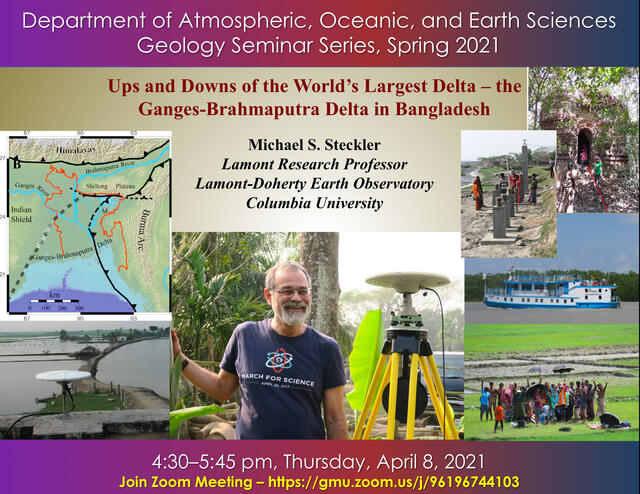
9 Apr (CLIM) Current Climate Conversations (CCC)
Current Climate Conversation
Fri., 1:30
Quasi-monthly AOES discussion of notable recent climate and weather events. Come with an interesting news item. Come to add your two cents. Or just come to listen.

14 Apr (CLIM) Student Seminars #2
Climate Dynamics Doctoral Student Presentations
Zachary Chester
Applying Machine Learning to Predict NO2 Emissions from Power Plants in the United States
Douglas Nedza
Separating External Forcing and Internal Variability in North Atlantic SST
Wed 1:30
15 Apr (GEOL) To be announced
To be announced
Thu, 4:30-5:45pm
16 Apr (CLIM) Manthos, Climate MS Thesis Defense
Zachary Manthos, Climate Science MS Program
Connecting Surface Weather Over North America To The Mid-Latitude Seasonal Oscillation
Fri 1:30
Thesis Advisor: Kathy Pegion
The 120-day Mid-latitude Seasonal Oscillation (MLSO) and its possible connections to surface weather over North America are investigated. Atmospheric modes, such as the North Atlantic Oscillation (NAO), Pacific North American (PNA) teleconnection pattern, and the atmosphere-ocean coupled mode El Niño Southern Oscillation (ENSO), are known to have significant impacts on surface weather, e.g., temperature and precipitation. Understanding how the recently discovered MLSO affects the surface weather over North America will be useful for improving the extended-range forecast. The analysis of frequency ratios such as warm over cold and wet over dry and composite analysis reveal the influence of MLSO on surface weather. The impact of MLSO is also investigated in conjunction with other climate modes such as NAO, PNA and ENSO. All investigations are split into boreal summer and winter and the analyses of the MLSO combined with other modes are conducted for two modes of phasing: in phase and out of phase. These analyses reveal that the MLSO is an important factor in understanding the temperature variability over North America. It is also found that the MLSO plays a role in exciting variability when interacting with other modes exerting influence over the same region. Expected patterns of temperature and precipitation associated with well-known climate modes show deviation when they are further decomposed to account for the MLSO influence. The MLSO is a vital component to the climate system of North America and its affects elsewhere on the globe need to be investigated.
19 Apr (GEOL) Cherry, MS Thesis Defense
Lucas Cherry, Earth System Science MS Program
Redox landscape of Ediacaran-Cambrian evolutionary events
Mon, 19 Apr, 2pm
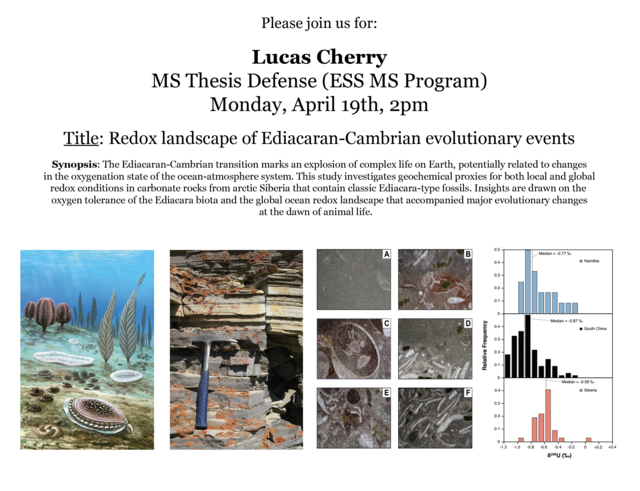
21 Apr (CLIM) Feldl, Lapse Rate Feedback & Polar Amplification
Nicole Feldl, U. California – Santa Cruz
The Lapse Rate Feedback: How climate feedbacks and atmospheric energy transport conspire to shape polar-amplified warming
Wed., 1:30
Arctic amplification of climate change is widely attributed to the sea-ice albedo feedback, with its attendant increase in absorbed solar radiation, and to lapse rate feedback - the effect of the vertical structure of atmospheric warming on Earth’s outgoing longwave radiation. I summarize results from idealized modeling experiments, in which polar feedbacks are systematically reduced, and present new diagnostic analyses across the ensemble of comprehensive ocean-atmosphere models. The distinct controls on the high-latitude lapse rate feedback are partitioned into “upper” and “lower” contributions originating from dynamically distinct regions: the high-latitude lower troposphere and the rest of the atmosphere. This decomposition clarifies how the positive high-latitude lapse rate feedback over polar oceans arises primarily as an atmospheric response to local sea ice loss and is reduced in subpolar latitudes by an increase in poleward atmospheric energy transport. The separation of the locally driven component of the high-latitude lapse rate feedback further reveals how it and the sea-ice albedo feedback together dominate Arctic amplification as a coupled, season-spanning, ocean-mediated mechanism.
22-23 Apr (CLIM) Graduate Symposium, Earth Systems Observations and Modeling
22 Apr (GEOL) Schmidt, Paleoceanography
Matthew Schmidt, Old Dominion
Paleoceanography
Thu, 4:30-5:45pm
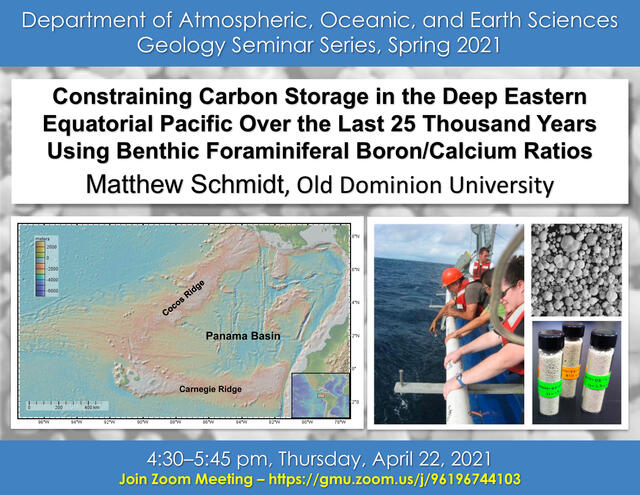
28 Apr (CLIM) Joshi, Wind Erosion During an Arizona Dust Storm
Janak Joshi, AOES
Dust storms over south-central Arizona have caused numerous highway accidents and health risks. This seminar will present a study to estimate the contribution of cropland wind erosion to the concentration of particulate matter with a diameter of 10 μm and smaller (PM10), during a typical springtime dust storm. The dust storm was simulated using a high-resolution (1 km horizontally) modeling system consisting of the Weather Research and Forecasting (WRF) model, a dust emission model (FENGSHA), and the Community Multiscale Air Quality (CMAQ) model. For this study, FENGSHA was revised to include new parameterizations for sandblasting efficiency and a roughness correction to threshold friction velocity; implementation of a dust source mask based on normalized difference vegetation index (NDVI) data; and implementations of up-to-date and high-resolution data on land use and soil texture.
The revised modeling system produced a realistic simulation of the dust storm compared against ground and satellite observations, indicating a high potential for an operational forecast system for early warning of dust-related hazards. More importantly, the simulations showed that about 50% of the regional PM10 during the dust storm originated at cropland. This highlights the importance of cropland as a dust source in emission inventories and air quality modeling. Given an increasing risk of regional dust problems due to climate change and groundwater reductions, studies of the kind presented here may aid the decision-making processes for allocating resources to mitigate dust hazards in vulnerable areas.
Wed., 1:30
29 Apr (GEOL) Hammer, Sedimentary Processes
Jonathan Hammer, GMU
Sedimentary Processes
Thu, 4:30-5:45pm
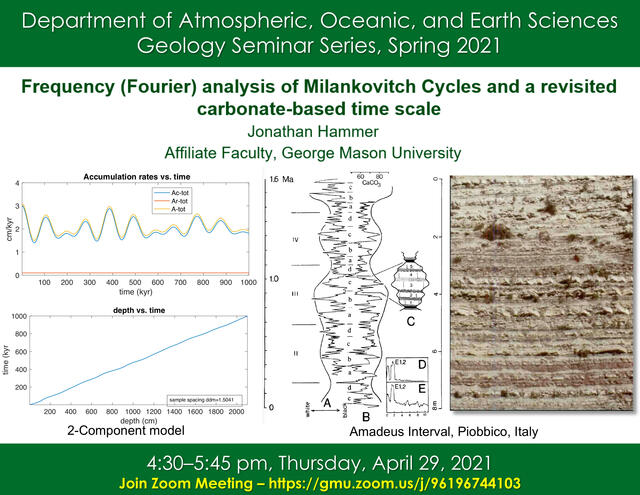
30 Apr (CLIM) Current Climate Conversations (CCC)
Current Climate Conversation
Fri., 1:30
Quasi-monthly AOES discussion of notable recent climate and weather events. Come with an interesting news item. Come to add your two cents. Or just come to listen.
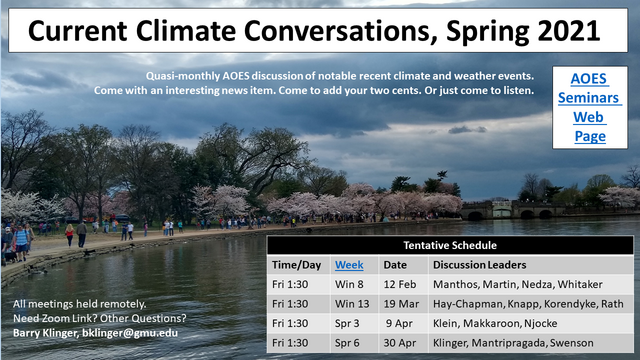
6 May (GEOL) Meyers, Paleoclimatology
Steve Meyers, University of Wisconsin
Paleoclimatology
Thu, 4:30-5:45pm
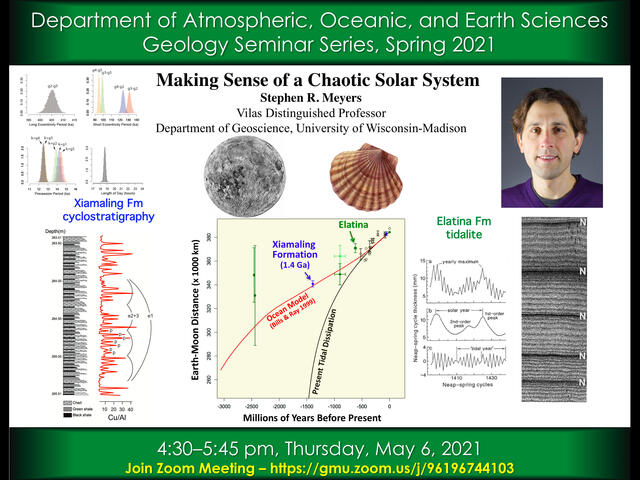
Fall 2020 AOES Seminars
All seminars via internet. To obtain link to seminar: For GEOL, see detailed information for individual seminar. For CLIM, contact bklinger@gmu.edu.
27 Aug (GEOL): Shuman, Polar Ice Sheets
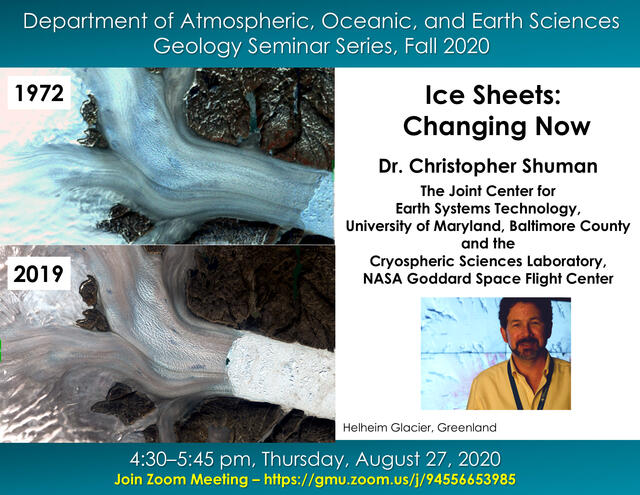
2 Sep (CLIM): Pegion, The COLA Datasets Catalog
Kathy Pegion, George Mason U. (AOES), and Noushin Behboudi
The COLA Datasets Catalog: An Open Source Data Catalog that Supports Internal Use and FAIR Data Standards
Wed, 1:30-2:30pm
We address several issues for data management in AOES/COLA:
• The need to manage large shared climate datasets across many users without a single coordinator.
• The need to manage remote datasets with adaptability to include datasets in the cloud.
• The need to meet FAIR data standards for research projects for large datasets.
To address these issues, we are developing an open source data cataloging system and producing a catalog that documents the metadata for our large internal data collection. The system is in Github and the catalog is rendered as a website. Internal users can easily determine what datasets are available, how to access them and where they were obtained from. Datasets can be added or updated by submitting issues and pull requests to Github, thus providing tracking of changes to the catalog.
The system is intended to be adaptable to any collection of datasets. For example, a small research group can generate a catalog to keep track of datasets being used by the group. A catalog of the datasets used for a journal article can be submitted as supplementary materials with the article to meet data access requirements. The catalog code is available in Github and version 1 is planned for release in early 2021.
3 Sep (GEOL): Powell, Paleozoic Brachiopods
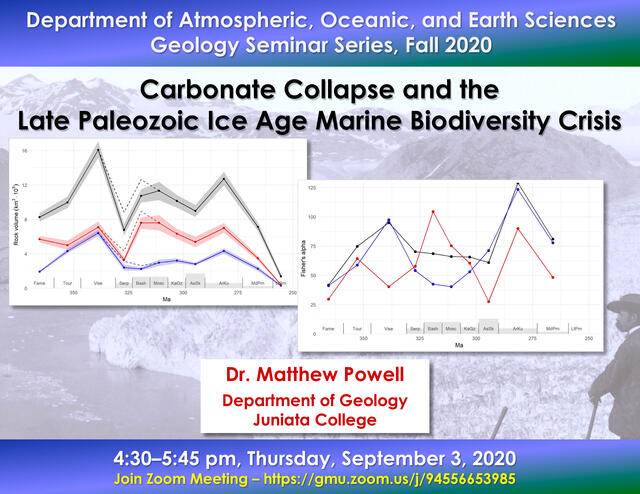
10 Sept (GEOL): Benison, Evaporites on Mars
Kathy Benison, West Virginia University
Evaporites on Mars
Thu, 4:30-5:45pm
Join Zoom Meeting:
https://gmu.zoom.us/j/94556653985
Meeting ID: 945 5665 3985
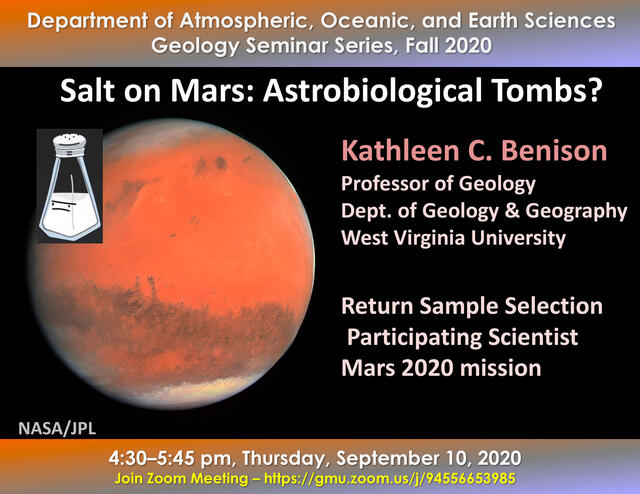
16 Sep (CLIM): Lee, Tropical Cyclone Activity
Chia-Ying Lee, Columbia U.
Subseasonal Prediction of Tropical Cyclone Activity
Wed, 1:30-2:30
I will present results from our NOAA S2S project that examines the probabilistic predictions of tropical cyclone (TC) activity -- genesis, occurrence, intensity (accumulated cyclone energy, ACE), and landfall-- at lead times of week 1- 4, in the Subseasonal to Seasonal (S2S) dataset. I will show that most S2S models evaluated have skill in predicting TC genesis and occurrence 4 weeks in advance. However, only the ECMWF model has skill in predicting the anomaly of TC activity from the seasonal climatology beyond week 1 in most global TC basins. Errors in genesis prediction largely limit models’ skill in predicting TC occurrence and ACE; S2S models are more skillful in predicting TC occurrence during favorable Madden–Julian oscillation phases. Calibrating forecasts through a linear regression method can better improve prediction skills when compared to mean-bias removal techniques. Lastly, I will briefly discuss our recent work on examining the monthly TC track forecasts from ECMWF at North Atlantic. Specifically, I will show how well the ECMWF model captures the observed track patterns through cluster analysis, and how tracks at each cluster are modulated by climate modes, such as ENSO and MJO.
17 Sept (GEOL): Anastasio, Estimating folding rates
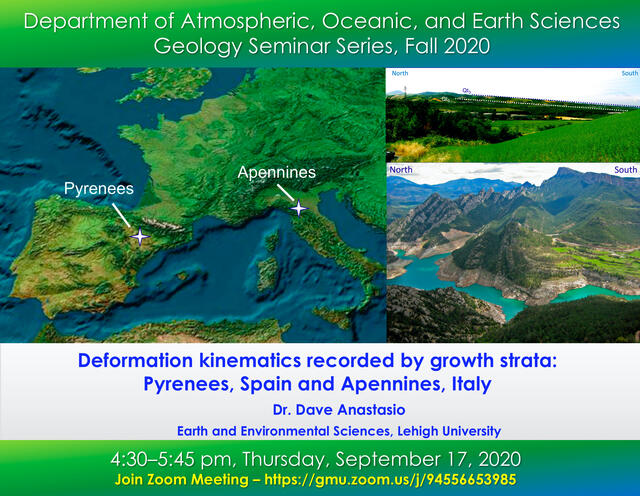
18 Sep (CLIM):Klinger, Current Climate Conversation
Barry Klinger (coordinator), George Mason U. (AOES)
Current Climate Conversation
Fri, 10-11am
Quasi-monthly AOES discussion of notable recent climate and weather events. Come with an interesting news item. Come to add your two cents. Or just come to listen.
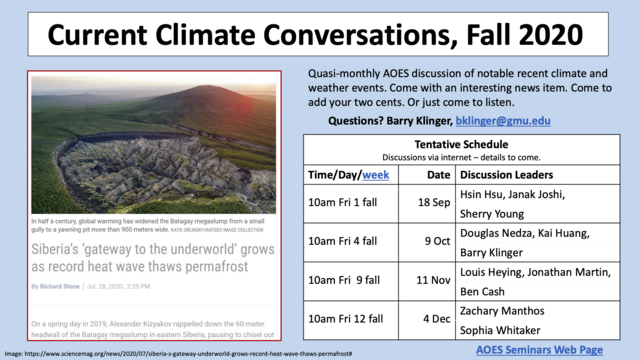
23 Sep (CLIM): Scheuerer, Neural networks for forecasts
Michael Scheuerer, NOAA Physical Sciences Laboratory
Using artificial neural networks for generating probabilistic subseasonal precipitation forecasts over California
Wed, 1:30-2:30pm
Ensemble weather predictions from global forecast systems require statistical postprocessing in order to remove systematic errors and to obtain reliable probabilistic forecasts. In this seminar we present two new postprocessing approaches based on artificial neural networks. The first approach uses rather basic neural network to link ensemble precipitation forecasts from a numerical weather prediction system to observed precipitation amounts. The second approach uses ensemble forecasts of large scale predictors like geopotential height at 500 hPa and total column water, and uses a convolutional neural network to link the associated weather patterns to observed precipitation amounts. Both methods are demonstrated with week-2, week-3, and week-4 forecasts of precipitation accumulations over California.
24 Sept (GEOL): Puckett, Gulf Coast quantitative biostratigraphy
Mark Puckett, Univ. of Southern Miss.
Gulf Coast quantitative biostratigraphy
Thu, 4:30-5:45pm
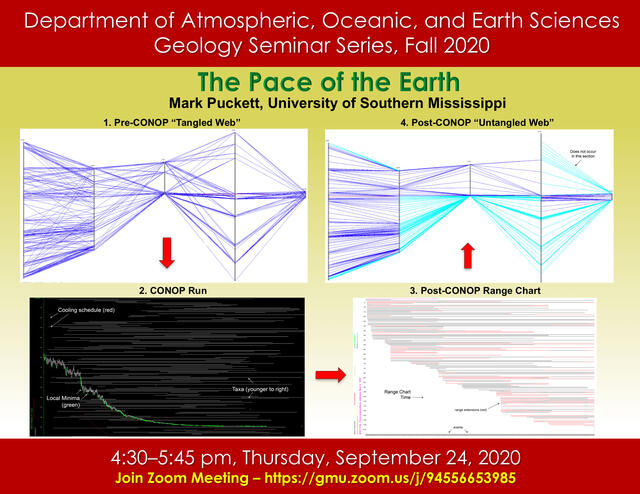
30 Sep (CLIM): Peng, Dynamical ENSO Forecasts
Peitao Peng, Wanqiu Wang, Yun Fan, NOAA Climate Prediction Center
Significant improvement of dynamical ENSO forecasts using an artificial neural network
Wed, 1:30-2:30pm
A common deficiency of operational dynamical El Niño-Southern Oscillation (ENSO) forecasts in the past decade is the recurrent ENSO false alarms issued in late boreal spring. Ultimate solutions to this problem rely on model improvements, which may take years or even longer. Another approach is correcting forecast errors through post-processing of the existing output from dynamical models. This study explores the value of an artificial neural network (ANN) in post-processing to the enhancement of dynamical model performance in ENSO forecasts. By applying the ANN to the North American Multi-model Ensemble (NMME) hindcast and forecast data, it is found that the false alarms can be effectively silenced, and the overall forecast skill of all leads can be significantly improved as well. Further analyses show that the information contributing to the ANN correction is primarily from the model forecasts in the Northwestern Tropical Pacific region, where forecasted sea surface temperatures (SSTs) are well correlated with the observed Niño 3.4 SST index. This finding suggests that correctly representing the relationship between SSTs in the Northwestern Tropical Pacific and that in the tropical central-eastern Pacific in dynamical models is critical to an improved dynamical ENSO forecast.
1 Oct (GEOL): Belmecheri, Trees, fire and climate change
Soumaya Belmecheri, National Science Foundation
Trees, fire and climate change
Thu, 4:30-5:45pm

7 Oct (CLIM): Lübbecke, Weakening Tropical AMOC
Joke Lübbecke, Helmholtz Centre for Ocean Research, Kiel
Does the Tropical Atlantic Show Signs of a Weakening AMOC?
Wed, 1:30-2:30pm
8 Oct (GEOL): Malinverno: Magnetic anomalies and the GPTS
Alberto Malinverno, LDEO
Magnetic anomalies and the GPTS
Thu, 4:30-5:45pm
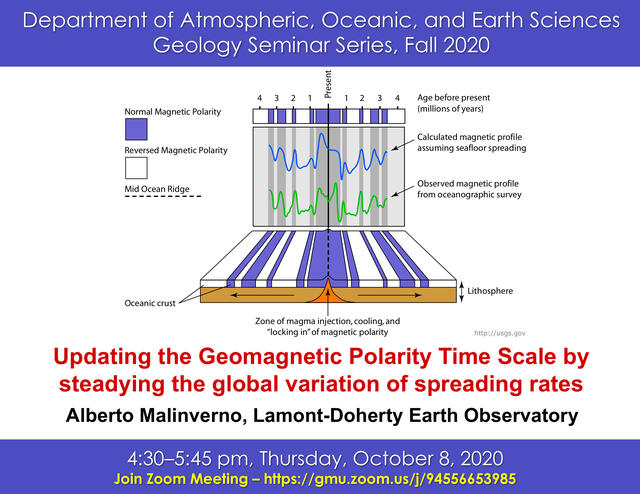
9 Oct (CLIM): Current Climate Conversation
Barry Klinger (coordinator), George Mason U. (AOES)
Current Climate Conversation
Fri, 10-11
Quasi-monthly AOES discussion of notable recent climate and weather events. Come with an interesting news item. Come to add your two cents. Or just come to listen.

14 Oct (CLIM): Dominguez, Amazonian Hydroclimate
Francina Dominguez, U Illinois,
with Jorge Eiras-Barca and Zhao Yang
“Beating” of the Amazonian Hydroclimate and Possible Future Changes
Wed., 1:30-2:30
Between 20 and 40% of the precipitation that falls over the Amazon basin comes from evapotransportation within the forest itself. Water vapor tracers embedded within an atmospheric model allow us to “tag” and track the moisture originating in the Amazonian basin. This analysis led us to the discovery of a characteristic “beating” of the atmospheric moisture of Amazonian origin. While the timescale of total water vapor is dominated by the annual cycle, that of Amazonian origin ebbs and flows with a very important diurnal cycle instead. The characteristic timescales of evapotranspiration, precipitation and moisture transport by winds drive the variability. I also discuss using tracers to analyze the possible impacts of future Amazonian deforestation on future hydroclimate patterns. During the dry season, deforestation leads to decreased evapootranspiration, higher temperature and no changes in precipitation. During the wet season however, an increase in moisture export reduces precipitation in the Eastern Amazon. Contrary to expectations, the tracers show no evidence that precipitation decreases are due to recycling or changes in stability.
15 Oct (GEOL): Trayler, Miocene Patagonia
Robin Trayler, University of California-Merced
Miocene Patagonia
Thu, 4:30-5:45pm
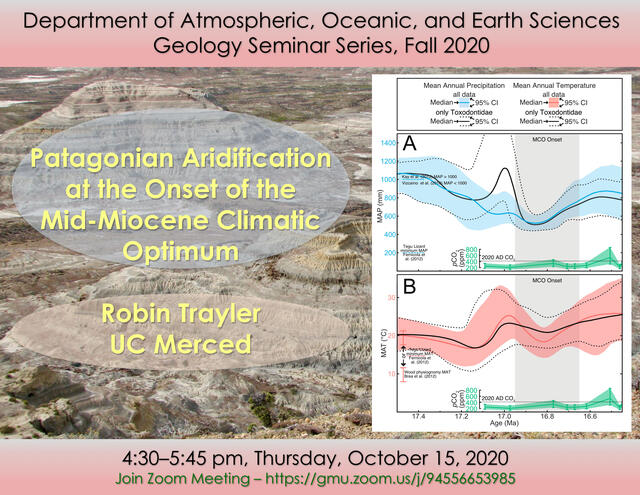
21 Oct (CLIM/GEOL): Lampkin, Greenland in a Warming Climate
Derrick Lampkin, U Maryland,
Understanding Greenland's Shear Margins in Warming Climate: Towards Decoding Dynamics in the Extra-marginal Field
Wed 1:30-2:30
The Greenland Ice Sheet has experienced unprecedented regional warming resulting in enhanced surface melting. The increase in melting has activated a dynamic surface hydrologic system contributing to significant mass loss. Contemporary work has attributed much of Greenland's mass loss through marine-terminating glaciers as a result of inland acceleration due to ocean-induced calving. Our work is starting to reveal a picture that is much more complex including calving, shear margin lubrication due to melt water injection and far-field supraglacial lake drainage. We have utilized satellite observations and numerical models to gain insights into how these processes might influence inter-seasonal dynamics within the extra-marginal ice field, which has implications for the evolution of Greenland’s marine-terminating outlet glaciers under a warming climate.
22 Oct (GEOL): Murphy, Pannotia and Pangea
J. Brendan Murphy, St. Xavier University
Global tectonics: Pannotia and Pangea
Thu, 4:30-5:45pm
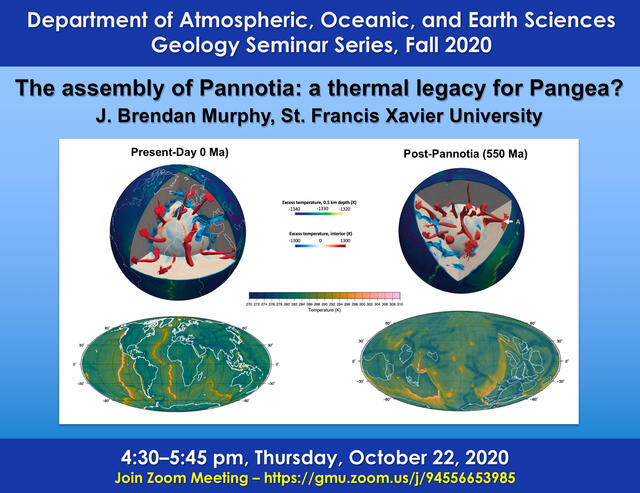
28 Oct (CLIM): Student Seminars
AOES PhD Students
Wed, 1:30-2:30
Finley Hay-Chapman, Land-Atmosphere Coupling States & Sensitivity
David Benson, SubX, Land-Air Interactions, and Heatwave Prediction
Paul Buchmann, Model Tuning: Initial Considerations
29 Oct (GEOL): Konecky, Tropical paleoclimate
Bronwen Konecky, Washington University
Tropical paleoclimate
Thu, 4:30-5:45pm
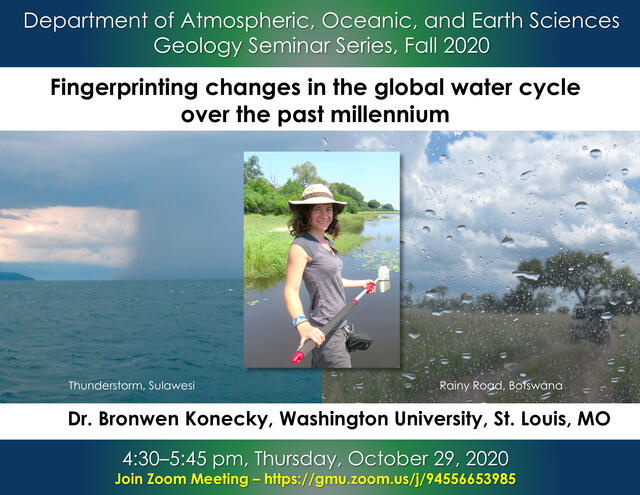
4 Nov (CLIM): Huang, Four Types of MJO
Kai Huang, George Mason University (AOES)
Process-Oriented Diagnosis of Four Types of MJO
Wed., 1:30-2:30
We present a process-oriented diagnosis of four types of Madden-Julian Oscillation (MJO) with different propagating features, including standing, jumping, fast and slow events. The moist static energy budget, cloud-radiation feedback, and boundary layer moisture convergence in the subseasonal time scale are diagnosed. The pre-moistening process and high-level radiation heating are found essential to MJO propagation. Also, the moisture tendency indicates a slowly westward-propagating wave structure over the central-east Pacific during the standing and jumping MJO life spans, mainly related to the zonal moisture advection. Therefore, MJO propagation characteristics are also likely affected by interaction between other convectively coupled equatorial waves.
5 Nov (GEOL): Wilson, GRACE satellite geodesy
Clark Wilson, University of Texas at Austin
GRACE satellite geodesy
Thu, 4:30-5:45pm
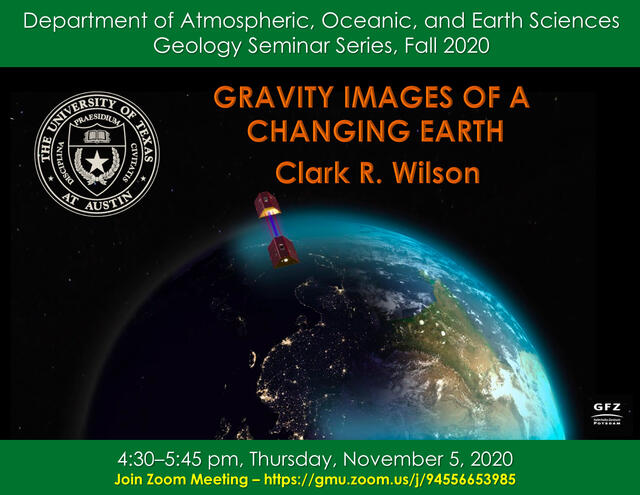
11 Nov (CLIM): Student Seminars
AOES PhD Students
Wed, 1:30-2:30
Scott Knapp, Water Isotope Signals in the Pliocene
Mary Korendyke, Seasonal Circulation Regimes in the PNA
Nikki Lydeen, Machine Learning for Dynamical Model Tuning
12 Nov (GEOL): Chamberlain, Climate-delta-tectonic interactions
Liz Chamberlain, Vanderbilt University
Climate-delta-tectonic interactions
Thu, 4:30-5:45pm
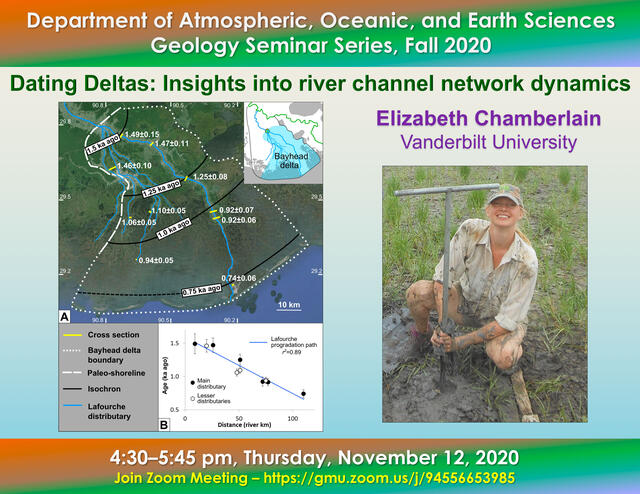
13 Nov (CLIM): Current Climate Conversation
Barry Klinger (coordinator), George Mason U. (AOES)
Current Climate Conversation
Fri, 10-11

18 Nov (CLIM): Fahad, Dissertation Defense
Abdullah al-Fahad, Geoge Mason University (AOES)
The influence of tropical diabatic heating and midlatitude static stability on subtropical anticyclones
Wed, 1:30
Subtropical Anticyclones located over the subtropical oceans of both hemispheres are a crucial
element of large-scale atmospheric circulation. Subtropical Anticyclones dominate midlatitude
weather and climate by influencing moisture transport, cyclone tracks, sea surface temperature,
and precipitation. However, the underlying mechanisms driving the formation and seasonal cycle
of Subtropical Anticyclones, as well as how they will respond to global warming still need further
investigation, especially in the Southern Hemisphere. The South Pacific subtropical anticyclone is
the only subtropical anticyclone that maximizes in area and strength during austral summer,
whereas the other four subtropical anticyclones peak in intensity during boreal summer with strong
Northern Hemisphere monsoonal heating. Given that the Southern Hemisphere summer monsoon
is relatively weak due to less Southern Hemisphere landmass, this raises the question: what drives
the austral summer intensification of the South Pacific subtropical anticyclone? Using reanalysis
data and heating experiments conducted with an atmospheric general circulation model, the first
component of this thesis finds that increased heating over the South Pacific Convergence Zone
triggers a Rossby wave response that increases the strength of the South Pacific subtropical
anticyclone in austral summer. The second component of this thesis investigates the mechanisms
that drive changes in the Southern Hemisphere subtropical anticyclones under global warming
within the CMIP5 & CMIP6 multi model ensembles. We find that a combination of local diabatic
heating and baroclinicity changes (through static stability) drive the projected changes in Southern
Hemisphere subtropical anticyclones under future global warming scenarios. Finally, sensitivity
experiments conducted with an atmospheric general circulation model show that slow subtropical
sea surface temperature warming primarily forces the projected changes in subtropical
anticyclones through baroclinicity change. Fast CO2 atmospheric radiative forcing on the other
hand plays a secondary role, with the exception of the South Atlantic subtropical anticyclone in
austral winter, where it opposes the forcing by sea surface temperature changes resulting in a muted
net response. Lastly, we find that tropical diabatic heating changes only significantly influence
Southern Hemisphere subtropical anticyclone changes through tropospheric wind shear changes
during austral winter.
19 Nov (GEOL): Goswami, Tectonic evolution of India
Arghya Goswami, Northwestern Missouri State Univ.
Tectonic evolution of India
Thu, 4:30-5:45pm
20 Nov (CLIM): Sorooshian, Modeling for Water Resources
Soroosh Sorooshian, U Cal Irvine
The role of hydroclimate modeling for regional water resources planning: Expectations, Promises, and Reality
Fri, 10:00
Addressing the needs of water resources management and hydrologic hazards requires information either from predictive models or traditional statistical methods. The most important hydroclimatological variable in this regard is precipitation and its regional projection into the future at different time-scales. With the recent exponential growth in the number of publications related to the use of climate models and regional downscaling studies in water resources, it begs the question of how effective and valuable the results of these studies are to the “user community”. The answer to this question is, how good are the future projections of precipitation in regions of interest.
This presentation reviews the expectations, promises and reality of the applications of Hydroclimate modeling in addressing hydrologic and water resources problems. Examples from some of the Coupled Model Intercomparison Project (CMIP) models and the North American Regional Climate Change Assessment Program (NARCCAP) studies over California will be presented. Availability of the recently released precipitation Climate Data Record (PERSIANN-CDR) for model evaluation with be presented and some preliminary results will be discussed.
2 Dec (CLIM): Bombardi, Monsoon Prediction
Rodrigo Bombardi, Texas A & M U
Bias and future trends in the annual cycle of monsoon precipitation in global climate models
Wed, 1:30-2:30
This study examines the annual cycle of monsoon precipitation as simulated by the Coupled Model Intercomparison Project phase 6 (CMIP6), with a particular focus on model bias in the present-day annual cycle and trends in future projections. The characteristics of the rainy season are well represented by CMIP6 models in present climate simulations over South America, southern Africa, and Australia. However, the models show severe problems simulating the North American Monsoon and the onset and summer precipitation associated with the Indian monsoon. Among the most reliable projections for the end of the 21st century are: a drying of the rainy season in South America and southern Africa, and a wetter Indian rainy season. In an effort to understand these regionally disparate changes, a relative moist static energy (RelMSE) is defined as the difference between the local surface air moist static energy and the tropical mean surface air MSE. Future changes in the RelMSE of each monsoon region are well-correlated with changes in onset and demise dates, suggesting that future changes in the timing of monsoons can be understood through controls on the energy content of surface air.
3 Dec (GEOL): Burgess, Geo-ecosystem structure and dynamics
Jerry Burgess, Johns Hopkins University
Geo-ecosystem structure and dynamics
Thu, 4:30-5:45pm
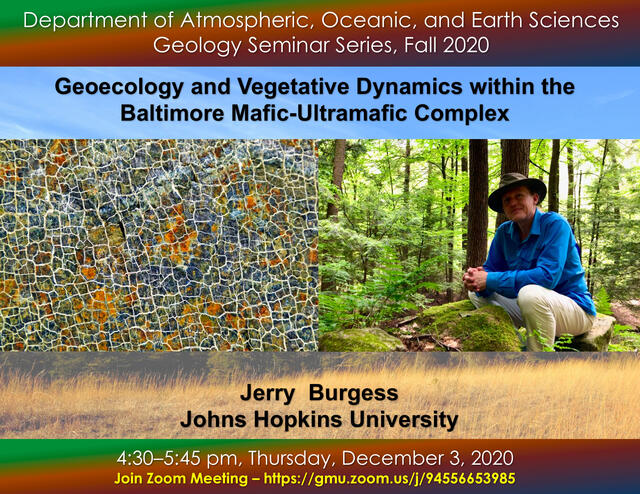
4 Dec (CLIM): Current Climate Conversation
Barry Klinger (coordinator), George Mason U. (AOES)
Current Climate Conversation
Fri, 10-11

Quasi-monthly AOES discussion of notable recent climate and weather events. Come with an interesting news item. Come to add your two cents. Or just come to listen.
Summer 2020 AOES Seminars
22 Jul: Teresa Cicerone, Climate Dynamics Doctoral Defense
The Sensitivity of the Tropical Atmosphere to Changes in Mixed-Layer Depth and Ocean Heat Flux Convergence Over the Indian Ocean
Wed., 1pm, via Webex [contact bklinger@gmu.edu for link)
The Madden-Julian Oscillation (MJO) is a tropical phenomenon that influences high-impact events such as hurricane activity and Asian monsoons on intraseasonal (2-8 week) time scales. However, the essential dynamical mechanisms responsible for the MJO are highly debated. Specifically, the role of the ocean on the MJO is unclear. Ocean dynamics has a negligible impact on atmospheric intraseasonal variability. Therefore, to gain insight into MJO-ocean interactions, we conduct climate model experiments where the ocean is replaced by a motionless slab whose thickness, called the mixed-layer-depth (MLD), varies in space but not in time. This slab-model configuration allows the atmosphere and ocean to communicate through surface fluxes of heat and moisture while suppressing interactive ocean currents. Consistent with previous studies, the MJO is nearly indistinguishable between the fully-coupled and slab-models. However, drastic changes in the MLD and ocean heat convergence over the Indian Ocean had no discernible impact on MJO propagation, predictability, or variability. This suggests that atmosphere-ocean coupling may not be critical to the MJO over the Indian Ocean. A discriminant analysis technique used to optimize the differences between experiments reveals that differences caused by changing Indian Ocean MLD were restricted mostly to surface fluxes and could be explained by simple physics. Despite precautions to preserve the climate, the control slab has a warmer climate than the fully coupled model. Generally, differences between fully coupled and slab models were consistent with changes associated with global warming, particularly the ``wet-gets-wetter" mechanism in a warmer climate.
